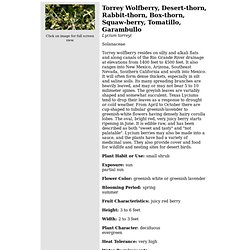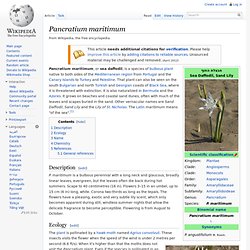

Google Image Result for. Mammillaria parkinsonii On-line Guide to the positive identification of Members of the Cactus Family. Mammilaria compressa (Pincushion cactus) (2) Brahea armata at San Marcos Growers. Machaeranthera tanacetifolia. Uses[edit] The Zuni people use an infusion of the flowers taken with other flowers for unspecified illnesses.[1] References[edit] Jump up ^ Camazine, Scott and Robert A.

Bye 1980 A Study Of The Medical Ethnobotany Of The Zuni Indians of New Mexico. Erythrina flabelliformis at San Marcos Growers. San Marcos Growers > Search > Base Search Results. Schotia afra var. angustifolia at San Marcos Growers. Pseudobombax ellipticum at San Marcos Growers. Eucalyptus formanii - Forman's Mallee. Agrostis atlantica. Uncarina decaryi. Uncarina blooms easily, and when covered with its flowers, it is a striking vision.

Cultivation: They are easy to grow heat resistant plant, which grow better than the average. They do best when grown in part shade to full sun. Their attractiveness is further enhanced because they will flourish very easily in any pseudo-tropical environment. Growing in well-drained soil with lots of water, when in growth and keep dry when dormant. Texas Native Plants Database. Torrey Wolfberry, Desert-thorn, Rabbit-thorn, Box-thorn, Squaw-berry, Tomatillo, GarambulloLycium torreyi Solanaceae Torrey wolfberry resides on silty and alkali flats and along canals of the Rio Grande River drainage at elevations from 1400 feet to 4500 feet.

It also ranges into New Mexico, Arizona, Southeast Nevada, Southern California and south into Mexico. It will often form dense thickets, especially in silt and saline soils. Its many spreading branches are heavily leaved, and may or may not bear 5 to 10 milimeter spines. Design Gallery. Panchito Manzanita: A Native Not To Miss. Panchito Manzanita (Arctostaphylos xcoloradensis) John Navant, Gargoyle Designs and Timberline Gardens Are you ready for a change?

Are you weary of the same old low growing groundcover junipers? Change is good! Are you searching for a broad leaf evergreen that could be used to replace those somewhat monotonous junipers and more? The plant you seek has to grow in poor soil, dry conditions and in full sun to partial shade. It is a selection from plants found near the Uncompahgre Plateau outside Grand Junction Colorado where it was collected by Dermod Downs about 15 years ago. This plant will grow to 10″-15″ in height and 36″-60″ in width in 3 to 7 years time. Gary Epstein of Ft. Geijera parviflora at San Marcos Growers. Pancratium maritimum. Description[edit] P. maritimum is a bulbous perennial with a long neck and glaucous, broadly linear leaves, evergreen, but the leaves often die back during hot summers.

Scape to 40 centimetres (16 in). Flowers 3–15 in an umbel, up to 15 cm (6 in) long, white. Corona two-thirds as long as the tepals. The flowers have a pleasing, exotic and very subtle lily scent, which only becomes apparent during still, windless summer nights that allow the delicate fragrance to become perceptible. Ecology[edit] The plant is pollinated by a hawk-moth named Agrius convolvuli. Easily grown but requires a very sunny position and a very well drained, sandy soil. Oenothera rhombipetala (Diamond petal primrose) Welcome to the Lady Bird Johnson Wildflower Center's collection of 33,341 plant images.

About the Image Gallery Contribute Images Image Use Policy Image Request Form How to Link to the Images Search image gallery: rate this image Oenothera rhombipetala Nutt. ex Torr. & A. Gray. Cuphea. Cuphea ignea flowers resemble a tiny burning cigar in color, hence the common name "cigar plant" Cuphea /ˈkjuːfiːə/[2] is a genus containing about 260 species of annual and perennial flowering plants native to warm temperate to tropical regions of the Americas.

The species range from low-growing herbaceous plants to semi-woody shrubs up to 2 m (6 ft 7 in) tall. Commonly they are known as cupheas, or, in the case of some species, as cigar plants. The generic name is derived from the Greek word κυφος (kyphos), meaning "bent," "curved," or "humped. Botanist Shirley A. Uses[edit] Aloes of Southern Africa (9781770074620): Gideon Smith, Braam van Wyk.
Catalina Cherry (Prunus ilicifolia ssp. lyonii) Catalina Cherry Scientific Name: Prunus ilicifolia ssp. lyonii (Eastw.)

RavenSynonym: Prunus integrifolia, Cerasus lyonii, Prunus lyoniiFamily: Rosaceae Can be used for hedges. Blooming Habits:Narrow spikes of white flowers, mid spring. Fruiting Habits:Red to black edible fruit, up to 1.2 inches in diameter (3 cm), with a thick, sweet flesh. Rosemary Mint, Desert Rosemary (Poliomintha incana)
Rosemary Mint, Desert Rosemary Scientific Name: Poliomintha incana (Torr.)

GraySynonym: Hedeoma incanaFamily: Lamiaceae Leaves and flowers can be used for seasoning or for herbal tea. Bocconia frutescens at San Marcos Growers. 15 Great Native Plants for Southwestern Gardens. Autumn Sage Salvias are tough to beat just about everywhere.

Autumn sage is an especially fine species that bears evergreen foliage and clusters of red, purple, pink, or violet flowers from late summer through autumn. Untitled. African Bulbs Homepage. Tacitus bellus. Tacitus bellus Scientific Name: Tacitus bellus Moran & J. MeyránSynonym: Graptopetalum bellumFamily: Crassulaceae This plant has been oscillating between the genera Tacitus bellus and Graptopetalum. Bushman Candle, Groot Kersbos (Sarcocaulon crassicaule) Bushman Candle, Groot Kersbos Scientific Name: Sarcocaulon crassicaule Rehm.Synonym: Sarcocaulon burmannii, Monsonia crassicauleFamily: Geraniaceae The name bushman candle refers to the layer of flammable wax that covers the stems of this plant. Puya chilensis. Puya chilensis Scientific Name: Puya chilensis MolinaSynonym: Family: Bromeliaceae Blooming Habits: Fruiting Habits: Check for Field Collection numbers at Ralph Martin's Site Sponsors: We do get a small commission out of these sponsors that helps financing the website.
New Mexico Plumseed, Desert Chicory (Rafinesquia neomexicana) New Mexico Plumseed, Desert Chicory Scientific Name: Rafinesquia neomexicana GraySynonym: Family: Asteraceae The genus is named after the 19th century botanist Constantine Samuel Rafinesque-Schmaltz. Blooming Habits:Large showy white flowers, 1 to 1.6 inches wide (2.5-4 cm), at the end of weak stems. Allelopathy: When Plants Attack! Biochemical warfare used by aliens on the attack sounds like the plot of an apocalyptic sci-fi story. However under the ground there is biochemical warfare occurring, invaders being repelled and defenders being overcome. Despite their apparent passive and inanimate natures, plants are continually battling against each other, against the elements and against everything that wants to eat them. One of the most interesting and controversial ways that this occurs is through allelopathy.
Allelopathy is defined as the event of one plant producing a chemical that does not cause harm to itself or members of its species, but harms others. Understandably, gardeners are particularly interested in allelopathic chemicals, because targeted weedkillers that affect everything but your prize carrots are highly sought after. Beaucarnea recurvata. Lady Banks' Rose (Rosa banksiae)